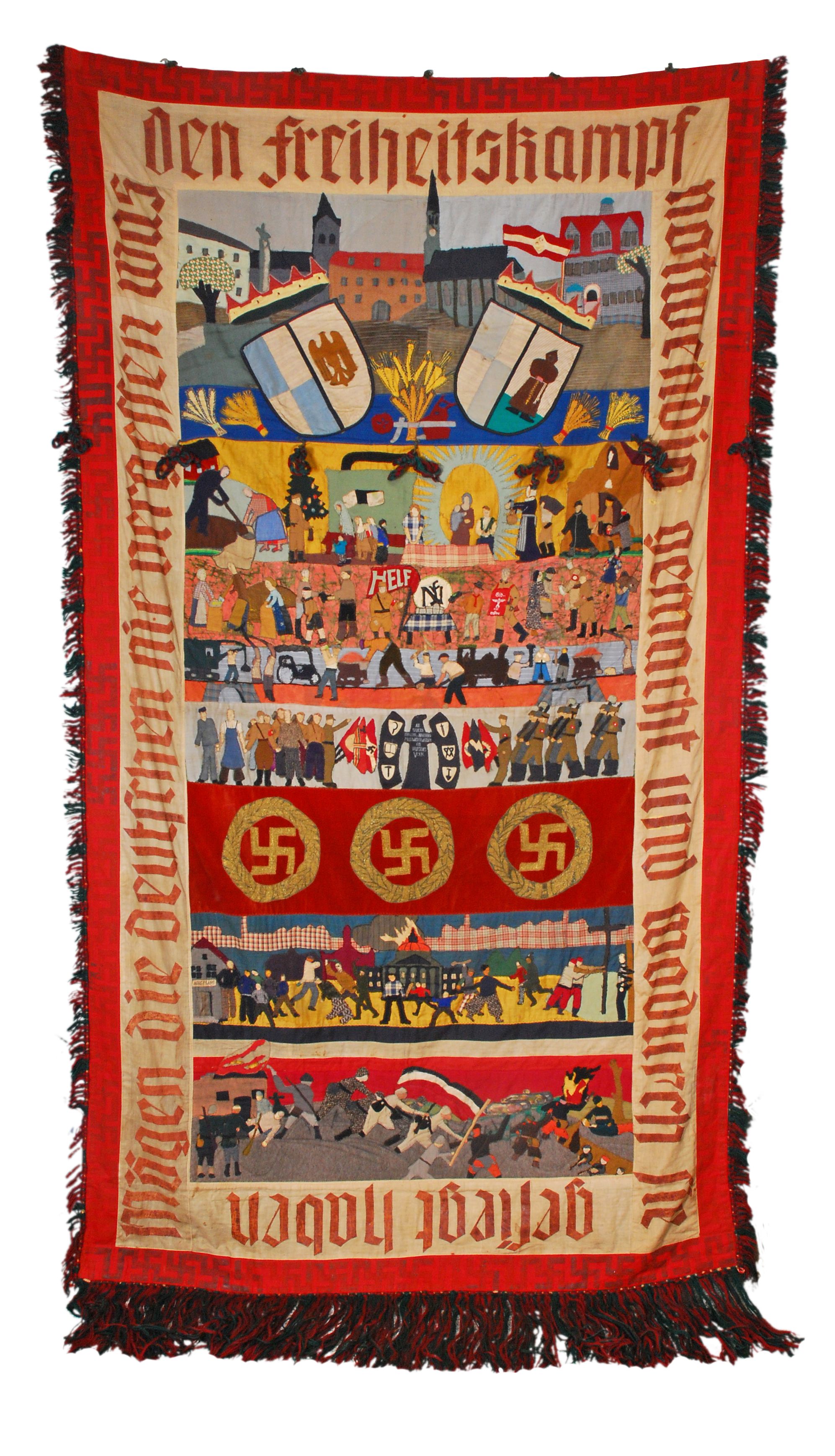
|
The incredible tapestry demonstrating in caricature the saga of the Third Reich
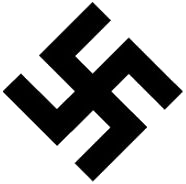 |
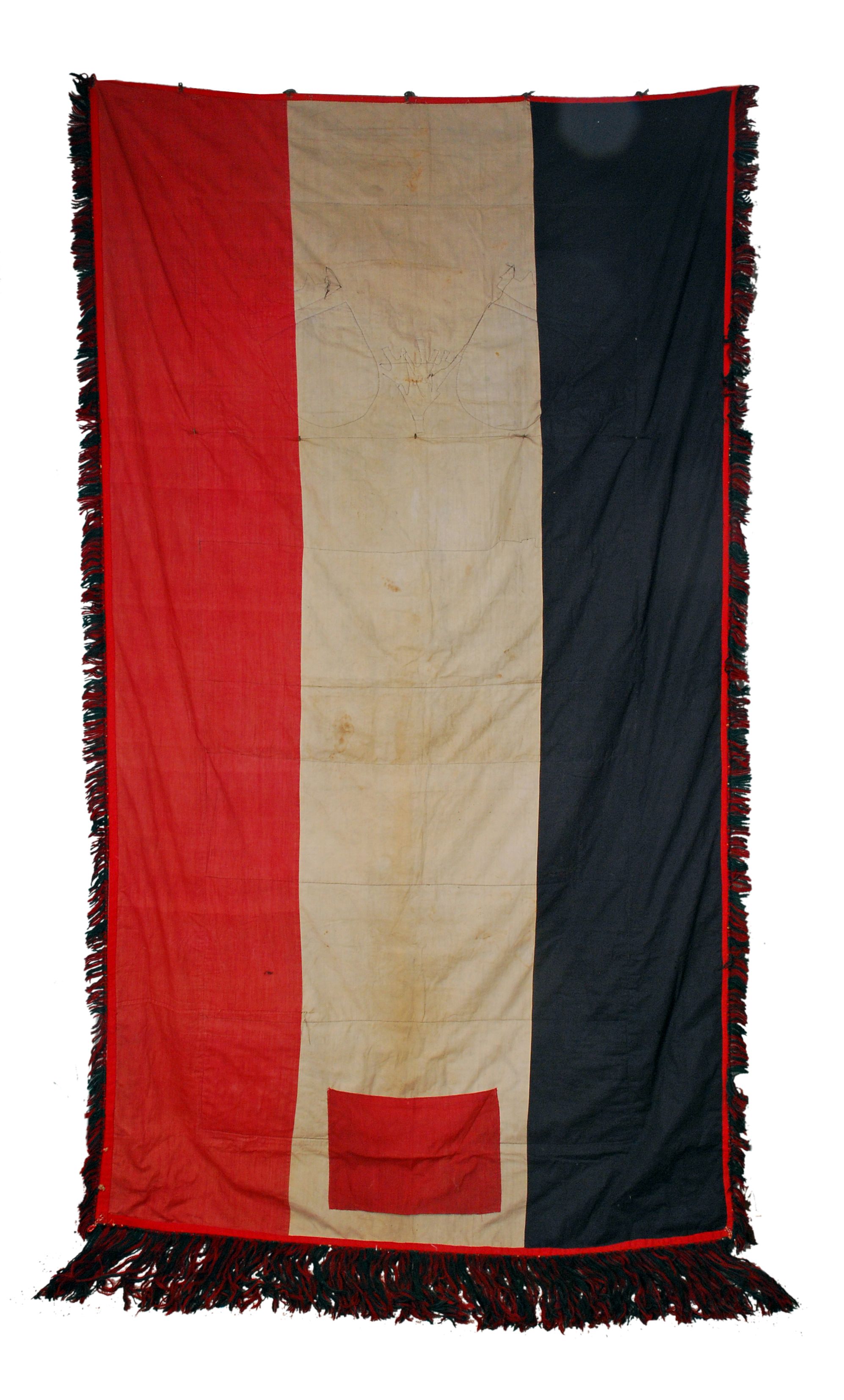
Backside of the tapestry showing the German national
colors used during the Third Reich
|
Fantastic National Socialist Tapestry that tells the Story of the Third Reich (Item TAPESTRY 1-1; ART 17-9b)
|
| DESCRIPTION: Here is one of the absolutely, most-fantastic art treasures of the Third Reich as depicted through the art of weaving. It traces the story of the National Socialist Movement and the catastrophic events that engendered it. The sequence follows a historical pattern and is a potpourri of various vignettes that pictorially illustrate some of many of the eventful scenarios that occurred before and after Hitler’s “Machtergreifung” (ascension to power).
The tapestry is presented in colorful panel art in full, vibrant colors woven by hand onto a woolen background material. All around the four edges are swastikas in sort of a Greek key pattern that was so prevalent in N.S.-period artwork. The words in German that are seen on the cream-colored inner section are as follows: “den Freiheitskampf” (“Struggle for Freedom”). Then around the edges are the words that translate: “May the German people never forget what made the war of liberation necessary and yet they have triumphed.” The first and top panel shows the crests of Munich with a scene of various buildings and the Feldherrenhalle where the famous Beer Hall Putsch marchers met a tragic end: it was here that the N.S. mythos was created in 1923. In the next panel, there are depictions of the German people and their everyday activities as a God-fearing, orderly people with ethics and morals aforethought, and having an intense and unshakable love for their Fatherland. This panel also represents the Volksgemeinschaft (people’s community) which united the different classes of workers and led to the restoration of Germanic family values and the return of employment, industry, and prosperity. In the third panel, these stout-hearted Teutonic folk are seen enjoying the social benefits offered when National Socialism was offered as a promised national relief after the horrors of WWI that was thrust upon Germany and its people; for instance, the horrid, vengeful Treaty of Versailles that punished them so unfairly and so very grievously. In the fourth panel, we see the people as they struggle through honest and dedicated labor to bring their nation back to its former glorious identity as the industrious power that it once was before Britain’s greed conspired to bring down the German nation. The fifth panel shows the various uniformed social organizations that were formed to benefit the nation’s resolve. These were the women’s Frauenschaft, the Reich’s Labor Service, the Hitler Youth, the SS, and the SA. Below this, we see a grouping of three golden swastikas encased in golden wreaths of oak leaves. This divides the positive aspects that are seen above that represent the awakening and arising of the German people brought about under National Socialism. Then, underneath this the dark panel illustrates the degradation and sheer horror bestowed on the Deutschen Volk and what they had to endure in the postwar era during the time of the Weimar Republic. This era saw the burning of the Reichstag (Parliament Building) by the Reds, the terrible time of chronic unemployment, the terrible Communist Insurrection, and the reprehensible persecution of the National Socialists by the police under the vicious police commissioner, Bernhard Weiss, in Berlin. This panel also depicts the martyrdom of nationalistic patriots such as the execution of the people’s hero, Albert Leo Schlageter, by the French in the occupied Rhineland. The last panel depicts the Germans who were finally awakened and united under National Socialism putting down the Spartacus revolutionaries, the Communists, and the hated French Army occupiers, and it shows the Freikorps (Free Corps) in action against all of these enemies of the Volk. So, in essence, the history of the movement and the temporary triumph of the Germanic people are graphically depicted in cloth. The tapestry is BIG! and not including the fringe it is 8 feet tall and 4 feet wide. This measurement does not include the seven round loops at the top of the tapestry that facilitate the hanging of it on a wall. They measure about ½ inch each. The tapestry weighs 15 or 20 pounds and was designed no doubt for display in a meeting hall probably in Munich, the Hauptstadt der Bewegung (capital of the movement), or possibly it hung in the Ratthaus (city hall). It just has that feeling! In any case, it is ranked among the best-looking tapestries we have ever seen in any collection. The deep and significant meanings are all encompassed into one masterpiece of the weaver’s art. In ancient Teutonic legend, there were three mysterious women called “Norns” and they weaved a special tapestry that controlled the metaphorical thread of life of every mortal from birth to death. We actually see a parallel here. The Norns were said to weave their tapestry that controlled man’s history and destiny. We can see something similar here in the fact that one, or perhaps all three women, weaved this Wandteppich (tapestry) that traced the history of the movement that really decided the destiny of Germany and, for that matter, the world. The tapestry of the Norns was weaved at the foot of Yggdrasil (World Tree), while this tapestry we present here was most probably woven by modern-day Norns in the National Socialist Women’s League called the NS-Frauenschaft. Its logo is in the center of the work. This, to my perception, is a sort of signature to the work since no other organizational symbol is used except for the banner of the Hitler Youth in the top panel, but that is shown waving from a school signifying the new N.S. education standards to the German people. We are tapestry people! This is possibly one of the prettiest tapestries we have ever seen as well as being so prodigiously historically important. We honestly believe that these Wandteppiche were the almost-sacred relics that when found can be seen to represent the great imperatives and the evidences of a culture that was both momentous and profoundly consequential to world history. This Kultur above all was the “Imperium” of the western world and its culture-bearing stratum is—alas—“gone with the wind!” and certainly with serious untoward negative consequences for the future. Hitler once said when officiating at the opening of the Haus der Deutschen Kunst in Munich: “Kein Volk lebt länger als die Dokumente seiner Kultur.“ Here is a grand unique special document of the National Socialist culture and saga in an art form that was sacrosanct to the N.S. culture almost exclusively in the 20th century. There never was another, and in this age of mostly degenerate art, it is likely that there never will be another.
|
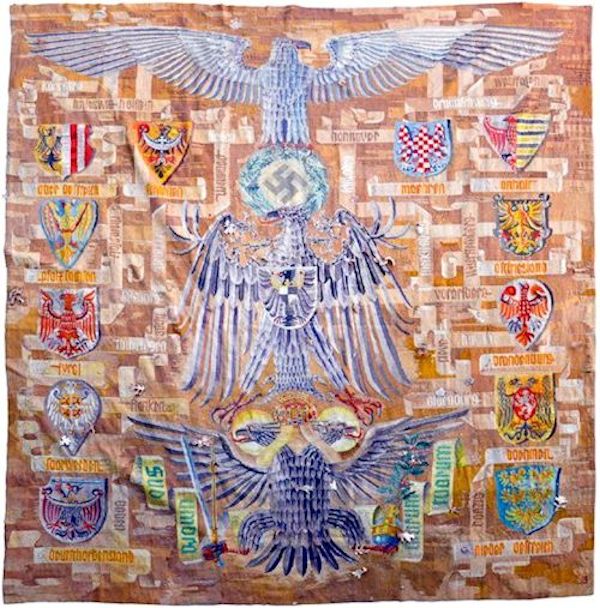
|

Karl Diebitsch's masterpiece titled “Mutter”
|
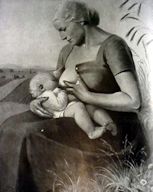
A later version of “Mutter” by Diebitsch
|
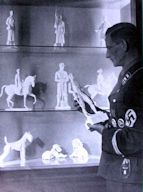
Karl Diebitsch in his Allach studio
|
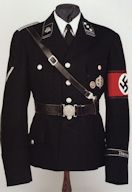
The Allgemeine-SS uniform designed by Prof. Diebitsch
|

Vase presented to Hitler that was designed by Prof. Diebitsch
|
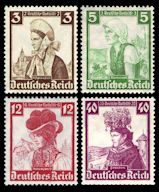
Some of the postage stamps designed by Prof. Diebitsch
|
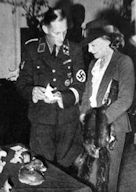
Prof. Diebitsch demonstrates Allach products to actress Hilde Hildebrand
|
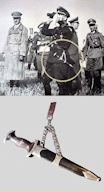
The chained model SS dagger designed by Prof. Diebitsch
|
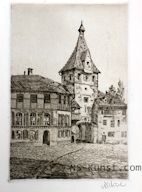
A rendering by Karl Diebitsch
|
|
“Der grosse Wandtappich” "The Great Tapestry" (Item TAPESTRY 1-2; ART 17-19a, SS-37-12)
|
DESCRIPTION: When our advisor R. Johnston visited and interviewed Professor and former  Oberführer Karl Diebitsch in Tegernsee, he intently listened as the professor spun the tales of the Allach porcelain legend that was so beloved to him. Diebitsch and his sister, Frau Elsie Seifert, told Johnston about the very beautiful and profoundly meaningful tapestries that Karl designed and she wove and constructed. These tapestries invariably told fascinating stories and they probed the mythos of the Teutonic past and proclaimed the glories of the National Socialist Third Reich. After the disastrous end of the Second World War, practically all of these wonderful art pieces disappeared into what seemed to be consummate oblivion. Professor Diebitsch seemed to feel that the tapestries were even more important to the National Socialist mythos than even the Allach porcelain and the Allach firm which he was, by the way, the founder of. At the time, Mr. Johnston was attempting to write a book on Allach porcelain and even more importantly he was gathering research on the tapestry of the Ahnenerbe Stiftung that hung in the offices of this wonderful heritage foundation based in Berlin. Professor Karl Diebitsch (January 1899–August 1985) was an artist personified, and he was the designer responsible for most of the regalia used by the Oberführer Karl Diebitsch in Tegernsee, he intently listened as the professor spun the tales of the Allach porcelain legend that was so beloved to him. Diebitsch and his sister, Frau Elsie Seifert, told Johnston about the very beautiful and profoundly meaningful tapestries that Karl designed and she wove and constructed. These tapestries invariably told fascinating stories and they probed the mythos of the Teutonic past and proclaimed the glories of the National Socialist Third Reich. After the disastrous end of the Second World War, practically all of these wonderful art pieces disappeared into what seemed to be consummate oblivion. Professor Diebitsch seemed to feel that the tapestries were even more important to the National Socialist mythos than even the Allach porcelain and the Allach firm which he was, by the way, the founder of. At the time, Mr. Johnston was attempting to write a book on Allach porcelain and even more importantly he was gathering research on the tapestry of the Ahnenerbe Stiftung that hung in the offices of this wonderful heritage foundation based in Berlin. Professor Karl Diebitsch (January 1899–August 1985) was an artist personified, and he was the designer responsible for most of the regalia used by the  to include the officer’s model chained to include the officer’s model chained  dagger and the well-known black dagger and the well-known black  uniform and also the uniform and also the  and police (Degen) ‘sword.’ It was he that did the original (entwurf) “designs” for all the most important tapestries that had and police (Degen) ‘sword.’ It was he that did the original (entwurf) “designs” for all the most important tapestries that had  themes. He received one of the top art prizes at the House of German Art for his remarkable oil painting titled “Mutter” (“Mother”). He also designed many of the Reich’s postage stamps. When Mr. Johnston visited Prof. Diebitsch the learned man did at one point describe how he came to be the designer of these wonderful tapestries and told Mr. Johnston that it was his sister, Elsie Seifert, that actually wove these wonderful Wandteppiche (tapestries) along with an assistant by the name of Fraulein Stronika. Their firm in Munich, if we remember right, was called München-Gobelin. When listening to Dr. Diebitsch as he described his many tapestries, there came a time when Frau Seifert gave Mr. Johnston quite a few original pictures of tapestries that she had created from the designs of her illustrious and highly talented brother. One thing that utterly fascinated Mr. Johnston was a certain artwork that both the professor and his sister described as ‘Der grosse Wandteppich”–“The Great Tapestry.” This, it would seem, was the most important and most beautiful one that they had ever produced. It was thought to be hung outside or inside the main entrance to Adolf Hitler’s office in the Reich’s Chancellery in Berlin. It may, however, have hung in the House of German Art in Munich before going to its final destination and it’s also possible that it never got to the Reich’s Chancellery and we can, I suppose, be grateful that it did not, since the chancellery was entirely gutted and all contents burned by the vicious barbarian hordes that steamrolled over all of Berlin. Diebitsch and his sister were deservedly proud of all their tapestries, but this one was not only their pride and joy, but they thought it to be the most important one produced as it depicted German glory through the ages. Unfortunately, however, they did not have a single picture of it. Evidently there were numerous pictures of it in a special album that Frau Seifert
put together back in the era, but the album was stored at the offices of München-Gobelin Wandteppichwerk and the building was completely burned when allied bombs hit the display and storage units and destroyed many other precious artworks as well as this precious album. Mr. Johnston does remember that they told him this tapestry splendidly imparted the romance and history of the First, Second, and Third Reichs with symbols depicting all these empires and it had heraldic shields that included the Wappen or crests of several of the most important districts of the united Reich and the Holy Roman Empire. This remained stuck in Johnston’s mind over the years since his meeting with the professor and he often thought he would absolutely love to see a picture of this fabulous work of the weaver’s art. However, he figured and was sure he never would. Then! In May 2014, he saw to his absolute amazement suddenly that there was a giant tapestry that was featured in the auction offerings of Mohawk Arms in New York. The tapestry was being called the “N.S. Reichstag National Culture-Gobelin Tapestry.” The minimum bid was shown to be $25,000 and amazing that it did not bring it, but it definitely takes a person steeped in history and culture to appreciate a masterwork such as this. Unfortunately, I did not see it until after the auction was concluded and I couldn’t have handled it at that time in any case, even though my advisor, R. Johnston thought it to be definitely the most important purchase that could ever be accomplished and he was positive that here was the actual Grosse Wandteppich but he did not see it, either, until the auction was over. He was and is sure that it is most assuredly the very same “great tapestry” as described by Professor Diebitsch and Frau Seifert. Later, it came up again in another auction, but still it was with a very substantial starting bid. This was included in the “History Hunter Auction” where it was featured with a minimum bid of $25,000, but again we did not buy it. Why? Frankly, we knew it was worth a great deal more but the item came up again just when we had a crisis in hand. Then, miraculously, we finally had a last chance to buy it from the original owner at a time when we were able to do so with the welcome help of a well-known dealer in the field. This was one of the greatest highlights of any career in this particular line. The dealer knew that of all the collectors and dealers in this field that Germania International would be almost singular in a true appreciation and knowledge of such an important cultural item like this. In addition, of course, I personally can attribute this to the knowledge of R. Johnston, an astute historian of long standing. This piece is more culturally important than any of the wonderful tapestries dedicated to the astounding Third Reich mythos, and this one, Der grosse Wandteppich, is surely the most important of all! themes. He received one of the top art prizes at the House of German Art for his remarkable oil painting titled “Mutter” (“Mother”). He also designed many of the Reich’s postage stamps. When Mr. Johnston visited Prof. Diebitsch the learned man did at one point describe how he came to be the designer of these wonderful tapestries and told Mr. Johnston that it was his sister, Elsie Seifert, that actually wove these wonderful Wandteppiche (tapestries) along with an assistant by the name of Fraulein Stronika. Their firm in Munich, if we remember right, was called München-Gobelin. When listening to Dr. Diebitsch as he described his many tapestries, there came a time when Frau Seifert gave Mr. Johnston quite a few original pictures of tapestries that she had created from the designs of her illustrious and highly talented brother. One thing that utterly fascinated Mr. Johnston was a certain artwork that both the professor and his sister described as ‘Der grosse Wandteppich”–“The Great Tapestry.” This, it would seem, was the most important and most beautiful one that they had ever produced. It was thought to be hung outside or inside the main entrance to Adolf Hitler’s office in the Reich’s Chancellery in Berlin. It may, however, have hung in the House of German Art in Munich before going to its final destination and it’s also possible that it never got to the Reich’s Chancellery and we can, I suppose, be grateful that it did not, since the chancellery was entirely gutted and all contents burned by the vicious barbarian hordes that steamrolled over all of Berlin. Diebitsch and his sister were deservedly proud of all their tapestries, but this one was not only their pride and joy, but they thought it to be the most important one produced as it depicted German glory through the ages. Unfortunately, however, they did not have a single picture of it. Evidently there were numerous pictures of it in a special album that Frau Seifert
put together back in the era, but the album was stored at the offices of München-Gobelin Wandteppichwerk and the building was completely burned when allied bombs hit the display and storage units and destroyed many other precious artworks as well as this precious album. Mr. Johnston does remember that they told him this tapestry splendidly imparted the romance and history of the First, Second, and Third Reichs with symbols depicting all these empires and it had heraldic shields that included the Wappen or crests of several of the most important districts of the united Reich and the Holy Roman Empire. This remained stuck in Johnston’s mind over the years since his meeting with the professor and he often thought he would absolutely love to see a picture of this fabulous work of the weaver’s art. However, he figured and was sure he never would. Then! In May 2014, he saw to his absolute amazement suddenly that there was a giant tapestry that was featured in the auction offerings of Mohawk Arms in New York. The tapestry was being called the “N.S. Reichstag National Culture-Gobelin Tapestry.” The minimum bid was shown to be $25,000 and amazing that it did not bring it, but it definitely takes a person steeped in history and culture to appreciate a masterwork such as this. Unfortunately, I did not see it until after the auction was concluded and I couldn’t have handled it at that time in any case, even though my advisor, R. Johnston thought it to be definitely the most important purchase that could ever be accomplished and he was positive that here was the actual Grosse Wandteppich but he did not see it, either, until the auction was over. He was and is sure that it is most assuredly the very same “great tapestry” as described by Professor Diebitsch and Frau Seifert. Later, it came up again in another auction, but still it was with a very substantial starting bid. This was included in the “History Hunter Auction” where it was featured with a minimum bid of $25,000, but again we did not buy it. Why? Frankly, we knew it was worth a great deal more but the item came up again just when we had a crisis in hand. Then, miraculously, we finally had a last chance to buy it from the original owner at a time when we were able to do so with the welcome help of a well-known dealer in the field. This was one of the greatest highlights of any career in this particular line. The dealer knew that of all the collectors and dealers in this field that Germania International would be almost singular in a true appreciation and knowledge of such an important cultural item like this. In addition, of course, I personally can attribute this to the knowledge of R. Johnston, an astute historian of long standing. This piece is more culturally important than any of the wonderful tapestries dedicated to the astounding Third Reich mythos, and this one, Der grosse Wandteppich, is surely the most important of all!
The Tapestry
The tapestry as far back as we can locate its history was sold by famed militaria dealer Tony Oliver in England to the well-known U.S. collector Jerry Davis about 45 years ago and during the time Oliver owned it he very unfortunately rented it out to the MGM film studio to be used in probably the movie that was even worse than the filth and genocidal murder depicted in the film Inglourious Basterds or even Rage. Brad Pitt and Lee Marvin should be drawn and quartered along with the rest of the miscreants like Quentin Tarantino who produces such garbage. Luckily, the tapestry only revealed the very bottom of itself and only for a few seconds and its brilliant integrity was not soiled by its misuse in the rotten film The Dirty Dozen. The tapestry was sold by Oliver to Mr. Davis for $10,000.00 in 1968. It shows the three Germanic Reichs while employing the symbolic eagles of each of these empires. We know that the Third Reich was a continuum of the Carolingian Empire and that of course is the double-headed eagle depicted at the base of the work and then above this is the eagle of the Second Reich with the eagle of the Hohenzollern Prussian Monarchy in the middle of its chest. Then above and of course dominant, is the eagle and swastika of the Third Reich. All through the tapestry are enjoyning bands with the names of the various historical districts that made up these proud and noble Reichs, and along with this can be seen the shields of these districts all in full vibrant color. This is an entirely handwoven Gobelin (not applique). Germania International has long been specializing in important Third Reich tapestries. Please read about such works of art at ART 17-19 on our site. There you will see the OKW tapestry that we thought was the most important tapestry of Third Reich origin ever offered and it certainly is and was until miraculously we found this one. No tapestry could exceed this one!! Among the twelve embroidered shields there are included the Wappen arms of Über Oestreich, Schlesian, Anhalt, Pfalz, Sachen, Ostfriesland, Tyrol, Brandenburg, Franken, Boehmen, Deutschordensland, and Nieder Oestreich. Other areas are named on the series of connecting legends. All three eagles are embroidered in shades of silver/gray/black and are more pronounced with the addition of other colors emphasizing crown, sword, orb, and oak leaves. The background consists of subdued shades of brown/tan/dull gold-brown. The absolute utter magnitude of this monumental tribute to the glory of what was once Germany (pre-Merkel) is astounding and if it survives and someday if sanity prevails it will be considered a true treasure of the Western experience–“Deutschland, Deutschland über alles, über alles in der Welt.”
PRICE: For now it will be priced upon request. Serious inquiries only.
|
|
Exceedingly Important Tapestries of the Third Reich |
|
The Grand OKW “Oberkommando der Wehrmacht” Tapestry (Item TAPESTRY 1-3; ART 17-19: SS 38-2)
|
DESCRIPTION: We start this narrative with a statement that should go at the end, and that is: “What could be more important than this magnificent and prodigiously important relic of the Third Reich?” Here is the unique (and I use the term “unique” for its intended definition—“One of a Kind”) Wandteppich (tapestry) that once hung in the headquarters of the Supreme Command of the German Armed Forces. The OKW or Oberkommando der Wehrmacht was the organization that was responsible for all preparations for national defense in time of peace and for the conduct of operations in time of war. The head of the OKW was a cabinet member and represented the joint interest of the three branches: army, navy, and air force with respect to other departments of the government. The OKW was supreme and fully responsible for the coordination of the active war effort by the three subordinate branches, while the OK der Heeres (army) is responsible for all army matters, just as each of the other two high commands—air force and navy—were responsible for the application of general policies within each one's own sphere. In wartime, each high command had a forward echelon and a rear echelon. The forward echelon moves to a location appropriate to the theatre of main operations, while the rear echelon remains in the Berlin area; actually the building was Wündsdorf near Zossen in the outskirts of Berlin. Although it was not as grand as Göring’s air-ministry building on the Wilhelmstrasse it still was a classic example of Third Reich architecture. A branch of the OKW was on the Bendlerstrasse; now named the Stauffenbergstrasse after the traitor Claus von Stauffenberg who was a would-be assassin who planned with other army officers to murder the Führer. When the coup failed he was shot by firing squad on the spot. The fantastic tapestry was either from this HQ or the one in Wündsdorf-Zossen. Many of the very important Third Reich buildings had handmade tapestries within but the total amount couldn’t be over a dozen. We at Germania have owned and found homes for the tapestry’s from the  -Deutsches Ahnenerbe that was located in Berlin, and the Lebensborn tapestry that came from the Steinhöring home known as “Heim Hochland.” We have had several important smaller tapestries as well. The importance of tapestries to the National Socialist mythos cannot be underestimated. “The Norns” were in Norse mythology female beings who ruled the destiny of the gods and men as they spun the thread of fate at the foot of Yggdrasil (the world tree). They weave the threads onto a giant tapestry that predestines the lives of the human species. Recently a writer named Joan Schweighart wrote a story called “Gudrun’s Tapestry” based on Germanic legends. In the days when the church and great royal houses ruled the Germanic world tapestries were symbols of great wealth. Whenever official ceremonies or public celebrations were held, tapestries lent beauty and richness to the events. Bishops and kings welcomed important visitors with red carpets flanked by tapestry displays. Royal processions proceeded along routes flanked and marked with tapestries. So, with tradition being so prodigiously important to the N.S. artistic sense and because of the intellectual state of mind that prevailed, the display of tapestries became extremely aesthetically important to Hitler’s Reich. In the mid 1980s I had occasion to visit with former -Deutsches Ahnenerbe that was located in Berlin, and the Lebensborn tapestry that came from the Steinhöring home known as “Heim Hochland.” We have had several important smaller tapestries as well. The importance of tapestries to the National Socialist mythos cannot be underestimated. “The Norns” were in Norse mythology female beings who ruled the destiny of the gods and men as they spun the thread of fate at the foot of Yggdrasil (the world tree). They weave the threads onto a giant tapestry that predestines the lives of the human species. Recently a writer named Joan Schweighart wrote a story called “Gudrun’s Tapestry” based on Germanic legends. In the days when the church and great royal houses ruled the Germanic world tapestries were symbols of great wealth. Whenever official ceremonies or public celebrations were held, tapestries lent beauty and richness to the events. Bishops and kings welcomed important visitors with red carpets flanked by tapestry displays. Royal processions proceeded along routes flanked and marked with tapestries. So, with tradition being so prodigiously important to the N.S. artistic sense and because of the intellectual state of mind that prevailed, the display of tapestries became extremely aesthetically important to Hitler’s Reich. In the mid 1980s I had occasion to visit with former  -Oberführer and Professor Karl Diebitsch who was the artist responsible for the beginnings of the porcelain art industry known as Allach. He was also the designer of much of the SS regalia including the chained Mod 36 SS dagger. Go to our -Oberführer and Professor Karl Diebitsch who was the artist responsible for the beginnings of the porcelain art industry known as Allach. He was also the designer of much of the SS regalia including the chained Mod 36 SS dagger. Go to our  -Schutzstaffel page and at SS 36-14 find more information on Prof. Diebitsch and the dagger. It was Diebitsch who designed the black SS uniform. He also designed a whole series of tapestries for the SS and other N.S. groups. This fabulous tapestry may well be one designed by this brilliant artist. Another tapestry we have offered is the one known as the Himmler wall hanging. Go to SS 36-15 to see that one, which is the most colorful one we have ever encountered. You will find more information about tapestries there. I mentioned in that article that there was no more a valued article to the Third Reich doctrines than these great wall hangings. Professor Diebitsch designed them and they were constructed by his sister, Elsie Seifert, both in completely woven design or applique, or both. Diebitsch tapestries stood alone in the use of almost iridescent silk cloth used to highlight certain areas of the work with bright gold or silver hues such as you can see between the eagle’s limbs and behind the swastika on this OKW wall hanging. In the Himmler tapestry the gold is very evident and the highlights are the swastikas and oak-leaf branches. -Schutzstaffel page and at SS 36-14 find more information on Prof. Diebitsch and the dagger. It was Diebitsch who designed the black SS uniform. He also designed a whole series of tapestries for the SS and other N.S. groups. This fabulous tapestry may well be one designed by this brilliant artist. Another tapestry we have offered is the one known as the Himmler wall hanging. Go to SS 36-15 to see that one, which is the most colorful one we have ever encountered. You will find more information about tapestries there. I mentioned in that article that there was no more a valued article to the Third Reich doctrines than these great wall hangings. Professor Diebitsch designed them and they were constructed by his sister, Elsie Seifert, both in completely woven design or applique, or both. Diebitsch tapestries stood alone in the use of almost iridescent silk cloth used to highlight certain areas of the work with bright gold or silver hues such as you can see between the eagle’s limbs and behind the swastika on this OKW wall hanging. In the Himmler tapestry the gold is very evident and the highlights are the swastikas and oak-leaf branches.
The OKW Tapestry
This beautiful tapestry bears the stylized Wehrmacht eagle separately sewn on. The eagle looks to its left and clutches an oak-leaf wreath with four Teutonic swords crossing each other behind the wreath. The eagle’s limbs and talons are accented, as is the swastika with gold-bullion cloth that gives it a rather three-dimensional effect. The uppermost portion displays a curved bandeau while the underside has a decorative oak-leaf braid and numerous applied rosettes. Both sides have pressure marks from a frame that had contained it (when?) The wall hanging lay for decades in a small Russian museum outside Moscow and recently it was bought by our German picker and thus returned to Germany and is now in the U.S. This may be the most important tapestry of Third Reich origin ever offered. It is a big 16 x 8 feet (192 x 96 inches or 490 x 245 cm). Let it be said that only Germania International could bring such fabulous articles forth to the collecting public.
PRICE: For now it will be priced upon request. Serious inquiries only.
|
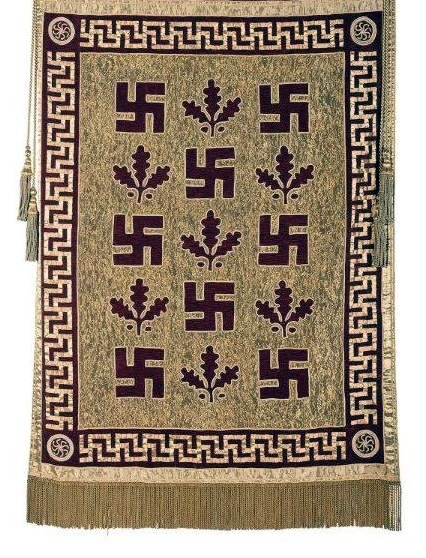
The Berchtesgaden Chancery tapestry; later in Himmler’s home
|
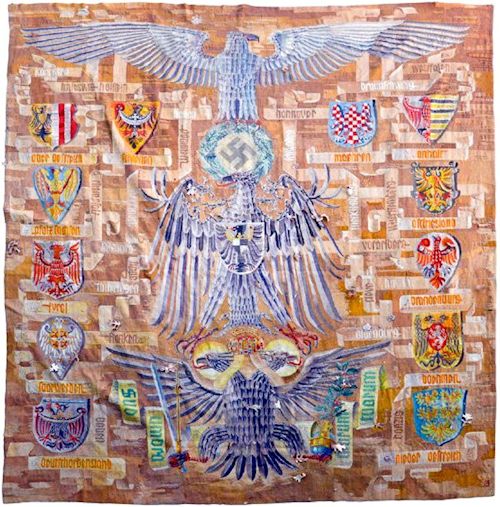
This is “Der Grosse Wandteppich” (The Great Tapestry), a genuine Munich Gobelin that was missing for many years and now discovered once again and is in a safe repository. This surely is the most meaningful tapestry to the Germanic mythus that was ever created in the Third Reich. It is huge--12 feet by 10 feet in size--and in its magnificent portrayals it shows the eagles of the three Reichs: the Holy Roman Empire is represented by the eagle at the bottom, and then the Hohenzollern Dynasty is represented, and after this at the top is the familiar and dominant eagle of the Third Reich.
Below are more Third Reich tapestries.
|
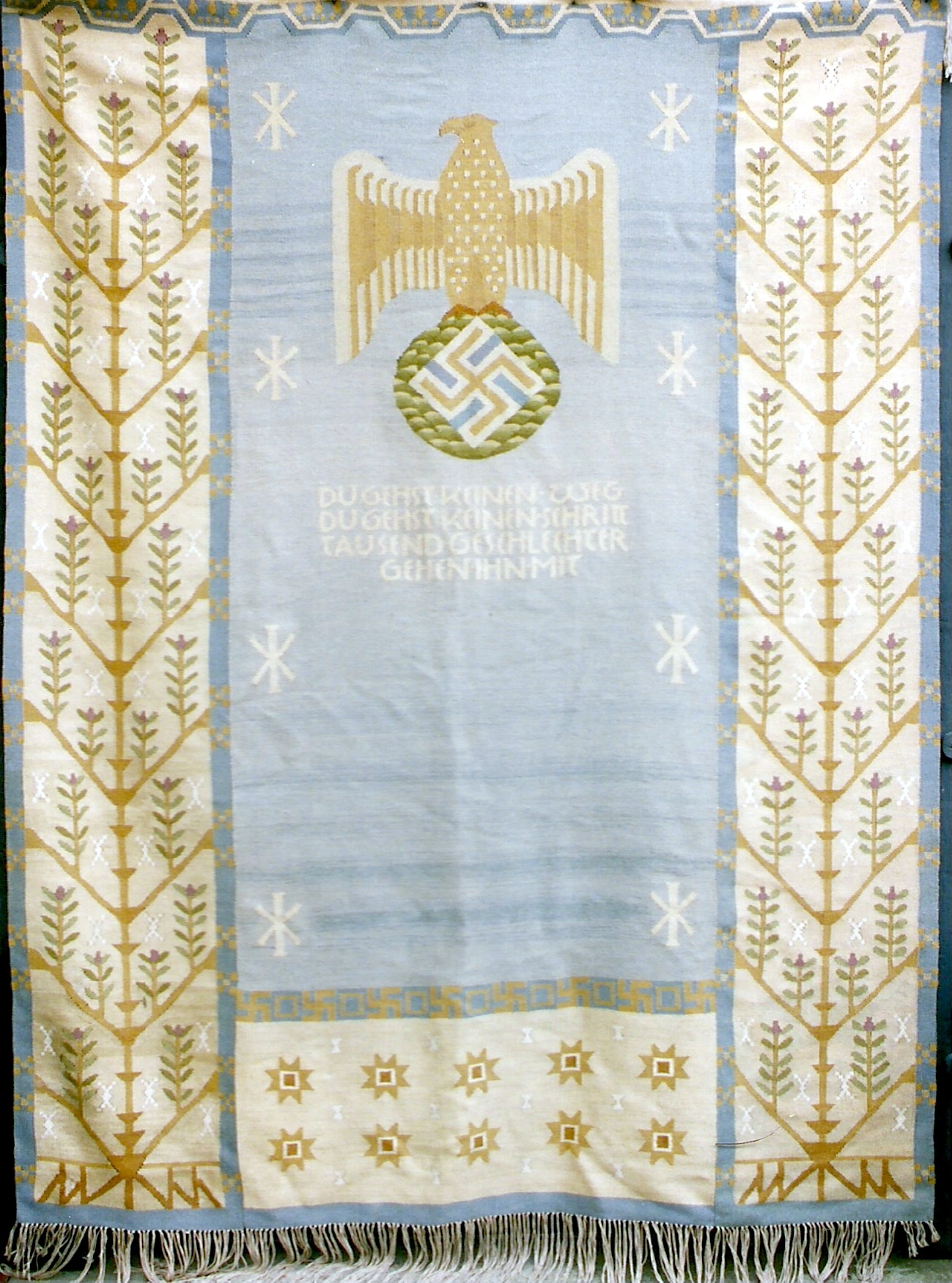
The Lebensborn tapestry: “When you walk on your way you cannot take one step when a thousand ancestors do not follow you."
|
| 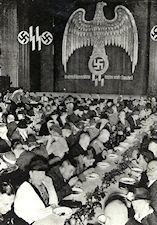
A giant Diebitsch tapestry as seen in the background of an  -sponsored Volksfest in Munich -sponsored Volksfest in Munich
|
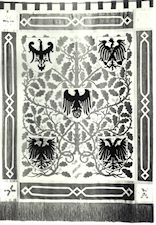
A tapestry by Professor Diebitsch depicting the history
of the symbol of the eagle of the German Reich
|
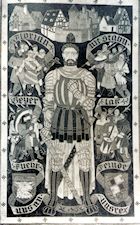
A Third Reich tapestry by Karl Heinz Dallinger; subject, the Knight Florian Geyer for the HQ of the 8th  Cavalry Division Cavalry Division
|
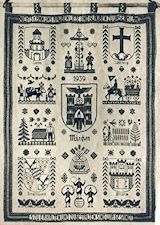
A Munich tapestry possibly made by Frau Hess, the wife of Rudolf Hess
|
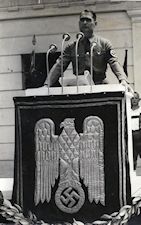
Deputy Führer Rudolf Hess with a silk-on-velvet tapestry
|
| 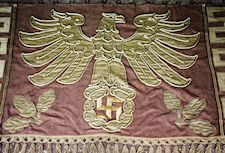
A tapestry from the parade that celebrated 2000 years
of Germanic culture and the opening of the House of German Art
|
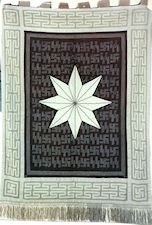
A Diebitsch tapestry made for the headquarters of  -Obergruppenführer and hereditary Prince Josias Waldeck Pyrmont in Arolsen. The star is the symbol of Arolsen. -Obergruppenführer and hereditary Prince Josias Waldeck Pyrmont in Arolsen. The star is the symbol of Arolsen.
|
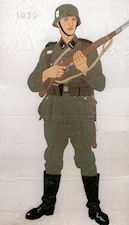
A tapestry by Elsie Seifert
|

A Third Reich podium tapestry
|
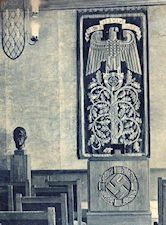
The Dallinger tapestry from the Nuremberg Gauleitung Ehrenhalle
|
| 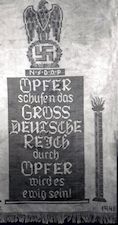
"Sacrifice created the Great German Reich, and sacrifice will make it eternal."
|
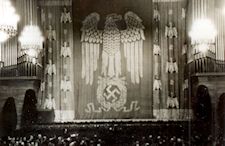
A theatre tapestry
|
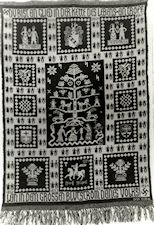
"You are but a link in the chain, a drop in the great bloodstream of your people!"
|
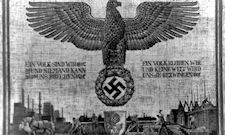
"We say from our mouths that no one can break our sprit.
We remain as a people and no world power will defeat us."
|
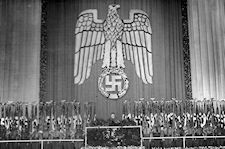
Gauleiter Burckel speaks to 15,000 political leaders
before an immense tapestry in Vienna.
|
| 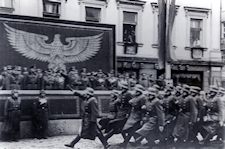
German police and  troops are reviewed by Heinrich Himmler who stands under a giant tapestry. troops are reviewed by Heinrich Himmler who stands under a giant tapestry.
|
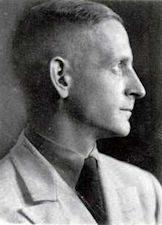
Professor and SS-Oberführer Karl Diebitsch;
possibly the designer of the tapestry
|
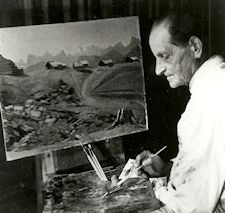
Professor Diebitsch in 1981--Ever the artist!
|
|
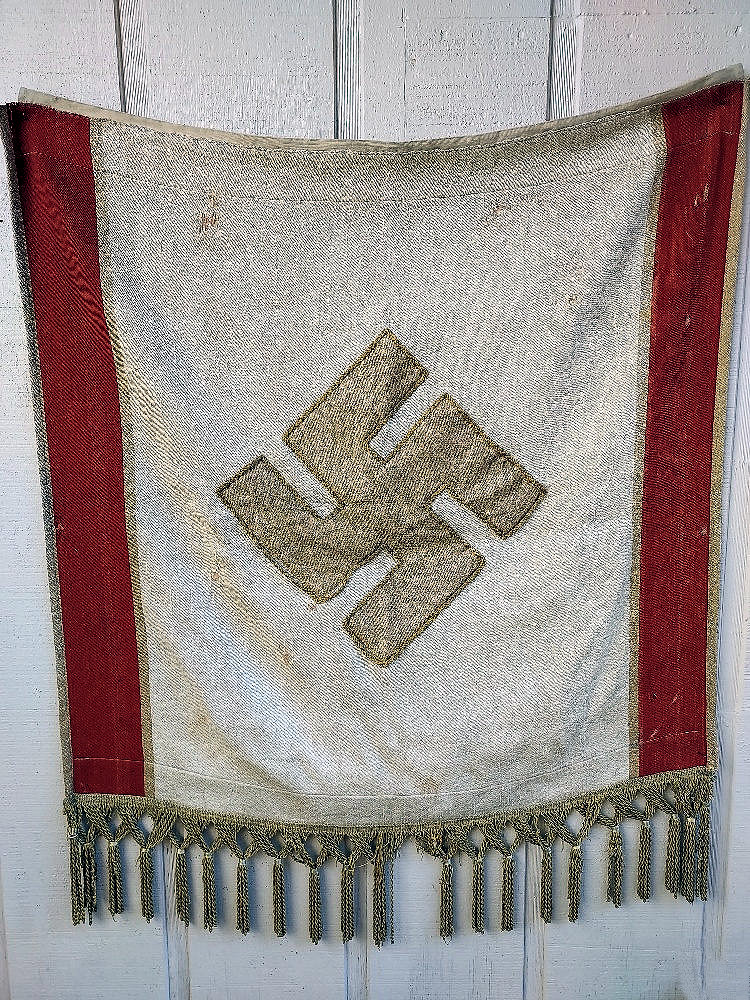
|
|
WWII Nazi German Gauleiter Opera-Box Tapestry. TREMENDOUS! (Item TAPESTRY 1-4)
|
| DESCRIPTION: It was customary in the Third Reich to decorate and personify special treatments of events to include important operas, and always the most influential personages attending who would be seated in a special opera box. There are many pictures of Hitler seated as such with his Führer Standarte in cloth that would be neatly draped in the front of his special box. We don’t know which Gauleiter was being honored with the inclusion of this particular design; however, we know it to be designated as such. The Berlin Opera House was generally the showplace for the special opera nights. The Gauleiter tapestries are extremely rare and we have only been able to offer one or two over the years. We only know of two or three of them that are in special collections. At least one of them that we know of was not fashioned for a Gauleiter, rather it was for the Supreme Commander of the Army, von Blomberg and shown at his box on a special performance of Wagner’s Gotterdammerung. The tapestry is very heavy and is single sided and made of heavy wool, printed with gold, flat-wire accents measuring 43 x 43 inches excluding the heavy gold fringe to the bottom. The swastika to the center is made of a separately applied flat-wired gold bullion with a thicker gold roping that matches the bottom fringe. There are a few minor surface holes that have not broken thru the fabric except for some small breaks on the red sides. There are also some smudges—nothing major, but to be expected. These are all noted in the images. There is an attached cloth at the top to slip a pole thru for hanging. One side of the braiding on the swastika is loose. All in all though, excellent construction and fine condition is noted! Probably one the of the most recognizable pieces of insignia associated with the Nazi regime is the swastika that’s used by nearly all of the organizations of the Third Reich. The swastika (Sanskrit for “well-being”) is an ancient symbol that actually goes back at least 20,000 years in Europe, and is in other cultures, as well. It signifies the sun and the circumpolar stars in the cycle of life. It was also a Germanic symbol for Thor, the great Teutonic God. During WWI, the swastika was used by such Germanic societies as the Thule Society and with other nationalistic movements and later assorted Freikorps groups. In the midsummer of 1920, Hitler adopted the swastika as the premier symbol of the NSDAP. In Mein Kampf, Hitler states that although numerous party members had proposed the swastika, and red, black, and white as the party emblem colors; it was Hitler himself who came up with the final design. The flag was adopted as the national flag of Germany after Hitler’s rise to power in 1933. To have something as rare and historically important as this powerful tapestry that emboldens the swastika so majestically is certainly a stellar event for the collector!
PRICE: $7,500.00
|
Contact Us
Please refer to item designator in parentheses in all correspondence.
Please E-mail for any additional information you may need.
If you prefer, contact 'Germania' at PO Box 68, Lakemont, GA 30552
or call at 706.782.1668.
Please! do not call during the wee hours of the morning. The best time for calling us is between 10 am and 12 noon and between 9 and 11 pm eastern time.
|

![]()
